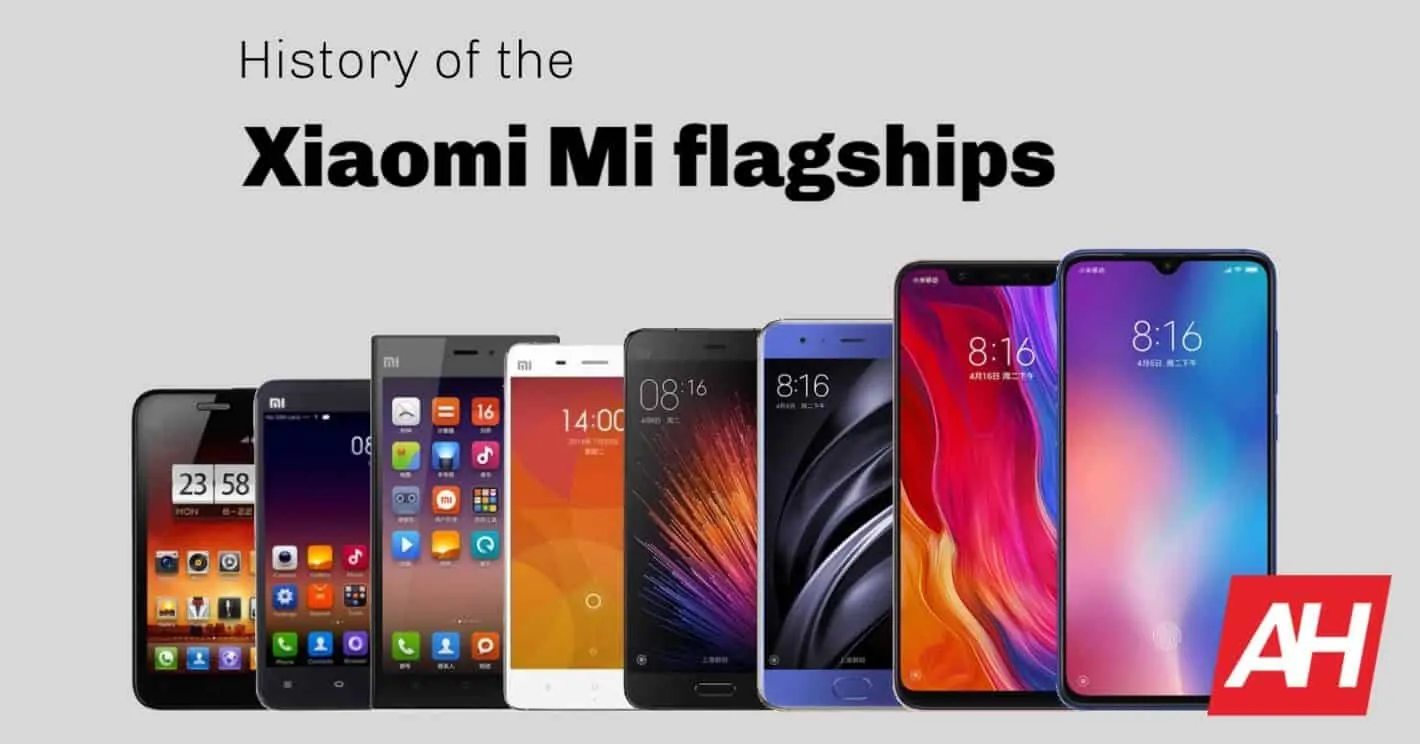The story of Xiaomi flagship Android smartphones started way back in 2011, when the company announced the Xiaomi Mi 1. Over the years, Xiaomi had introduced quite a few devices, but we’re here to focus on the company’s primary Mi flagship lineup of smartphones, not including the Mi Note and Mi MIX devices that were introduced at some point in time.
To this day, Xiaomi introduced quite a few major flagship smartphones, some of which shipped in more than one variant, which is also something we’ll mention here. Down below, you will find a breakdown of every single one of those Mi flagships, and it is also worth noting that the article will be updated when new phones get announced. The design of Xiaomi’s phones changed quite a bit over the years, and the same happened with specifications, needless to say.
Xiaomi Mi 1

The Xiaomi Mi 1 was announced back in August 2011 (it was rebranded to Mi 1S a year later, for different markets), and as pretty much every phone from that point in time, it sported rather noticeable bezels. The phone itself is not all that big, at all, as it sports a 4-inch display. The device includes three navigation keys below the display, the “Mi” logo above the display, and a single 8-megapixel camera on its back. A 2-megapixel camera is included on the phone’s front side.
The Xiaomi Mi 1 is fueled by the Snapdragon S3 dual-core processor from Qualcomm, and the device includes 1GB of RAM. The Xiaomi Mi 1 came with 4GB of RAM, and a 1,930mAh battery. The phone was priced at 1,999 Yuan ($310) at launch, and it took Xiaomi two months to bring it to market in China, it was available for pre-order in August, but it didn’t ship out to consumers until October.
Xiaomi Mi 2

The Xiaomi Mi 2 arrived in the same month as the Mi 1S, but the Mi 2 was a full-fledged successor to the Mi 1. This handset also includes capacitive navigation buttons below the display, but its bezels are thinner than the ones on the Mi 1. The Xiaomi Mi 2 was the very first smartphone to ship with the Snapdragon S4 Pro quad-core processor by Qualcomm, and the device features a 4.3-inch HD (1280 x 720) display, which is also an improvement over the Mi 1.
The Xiaomi Mi 2 comes with 2GB of RAM and 16GB / 32GB of storage, while expansion via a microSD card is not available. An 8-megapixel camera is included on the back of this smartphone, while a single 2-megapixel unit is placed on its front side. Android 4.1 Jelly Bean came pre-installed to the device, along with MIUI 5 skin from Xiaomi. The device includes a 2,000mAh battery, which is removable.
Xiaomi Mi 3

The Xiaomi Mi 3 was announced about a year after the Mi 2, in September 2013, while it was released in December that same year. The Xiaomi Mi 3 offers a somewhat different design compared to the Mi 2, it is noticeably boxier. The phone still features capacitive navigation buttons, but its bottom bezel is considerably thinner compared to the Mi 2. The company’s logo is placed above the display, and speaking of which, the Mi 3’s display is considerably larger compared to the Mi 2’s.
The Xiaomi Mi 3 features a 5-inch fullHD (1920 x 1080) LCD display, while the phone itself is made out of plastic, just like its predecessor. The device is fueled by the Snapdragon 800 quad-core processor, while it comes with 2GB of RAM and 16GB / 64GB of non-expandable storage. A 13-megapixel camera is placed on the back of this phone, while a 2-megapixel camera is included on the device’s front side. This handset features a 3,050mAh non-removable battery, which was considered to be quite large at the time. The device shipped with Android 4.3 Jelly Bean, and MIUI 5.
Xiaomi Mi 4

The Xiaomi Mi 4 got announced in July 2014, sooner than expected, as it arrived only 10 months after the Mi 3. The Xiaomi Mi 4 is less boxy than the Mi 3, and it offers a set of navigation keys just like its predecessor. The Mi 4 includes a display of the same size as the Mi 3, and the resolution is also identical, the phone sports a 5-inch fullHD LCD display. Android 4.4.3 KitKat comes pre-installed on this device, with Xiaomi’s MIUI skin.
The Xiaomi Mi 4 is fueled by the Snapdragon 801 quad-core processor by Qualcomm, and that SoC is not a huge step forward compared to the Snapdragon 800, but it was a solid processor back then. The phone arrived in both 2GB and 3GB RAM variants, with 16GB and 64GB of storage, respectively. A 13-megapixel camera is included on the back of this phone, an 8-megapixel camera is placed on the front, while the device includes a 3,080mAh battery. The Xiaomi Mi 4i and Mi 4c were also announced, but those were mid-range phones.
Xiaomi Mi 5

The Xiaomi Mi 5 was the first flagship in this series of smartphones to offer a glass back, and it was announced in February 2016. The phone includes a curved back side, while it also sports a fingerprint scanner on the front. Two capacitive keys flank that fingerprint scanner / home button, while the phone looks like a considerable improvement of the Mi 4 in terms of the design. The device also includes a frame made out of metal.
The Xiaomi Mi 5 features a 5.15-inch fullHD (1920 x 1080) display, 3GB / 4GB of RAM and 32GB / 64GB / 128GB of non-expandable storage. The phone is fueled by the Snapdragon 820 octa-core processor, and it ships with Android 6.0 Marshmallow out of the box. A 16-megapixel camera is included on the back of this phone, while a 4-megapixel unit is placed on its front side. This phone ships with a 3,000mAh non-removable battery, while its backplate is easily removable and replaceable.
The Xiaomi Mi 5s arrived in September 2016, and it is an improvement over the Mi 5, but not a major new release, that’s for sure. This handset is fueled by the Snapdragon 821, and it includes the same display as the Mi 5. The device arrived in both 3GB and 4GB RAM variants, while it is made out of metal, and it looks somewhat different compared to the Mi 5.
Xiaomi Mi 6

The Xiaomi Mi 6 represents an evolution of the Mi 5’s design, it was announced in April 2017. The Mi 6 is considerably heavier than its predecessor, and instead of a physical home key, it includes a capacitive one, which doubles as a fingerprint scanner. This phone also comes with two capacitive keys on each side of the home key, and it was the first phone in the series to sport two rear-facing cameras. The phone is made out of metal and glass, just like its predecessor.
The Xiaomi Mi 6 comes with Android 7.1.1 Nougat out of the box, while it is fueled by the Snapdragon 835 octa-core processor. The phone sports 4GB / 6GB of RAM and 64GB / 128GB of storage. Two 12-megapixel cameras are included on the back, while the phone sports a single 8-megapixel unit on the front. The Mi 6 includes stereo speakers, while a non-removable 3,350mAh battery is also a part of the package.
Xiaomi Mi 8

Xiaomi has decided to skip the Xiaomi Mi 7 naming, and it jumped from the Mi 6 straight to the Mi 8 in May of 2018, when the phone got announced. The Xiaomi Mi 8 is a huge change compared to the Mi 6, it is a lot larger than the Mi 6, not to mention that it comes with a rather noticeable notch at the top of the display. The phone is made out of metal, and it sports considerably thinner bezels than the Mi 6. The Xiaomi Mi 8 includes two vertically-aligned cameras on the back, and it got announced in the Mi 8, Mi 8 Pro, Mi 8 SE, and Mi 8 Explorer Edition variants. Only the Mi 8 SE is not a flagship-grade phone, though.
The Xiaomi Mi 8 features a 6.21-inch fullHD+ (2248 x 1080) Super AMOLED display, and is also the first phone in the series to offer an OLED panel. The phone is fueled by the Snapdragon 845 octa-core processor, and it includes 6GB / 8GB of RAM. The phone arrived in 64GB, 128GB, and 256GB storage variants, while it does not offer microSD expansion. Two 12-megapixel cameras are included on the back of this phone, while a single 20-megapixel unit is available on the front. A 3,400mAh non-removable battery is also a part of the package, while the phone shipped with Android 8.1 Oreo and Xiaomi’s MIUI skin back when it launched.
Xiaomi Mi 9

The Xiaomi Mi 9 is made out of metal and glass, like the Mi 8, but the device offers a somewhat different in-hand feel. The Mi 9 is arguably a much more appealing device than the Mi 8 in terms of the design, as it replaces the Mi 8’s huge notch with a tiny, teardrop notch. The bottom bezel is extremely thin, and the phone offers a rather high screen-to-body ratio. This handset includes an in-display fingerprint scanner, and three rear-facing cameras, which make it the first phone in the series to offer three rear-facing cameras.
The Xiaomi Mi 9 sports a 6.39-inch fullHD+ (2340 x 1080) Super AMOLED display, 6GB / 8GB of RAM and 64GB / 128GB of non-expandable storage. The phone is fueled by the Snapdragon 855 octa-core processor, while 48, 16, and 12-megapixel cameras are placed on its back. A single 20-megapixel unit is included on the phone’s front side, while the phone came with a 3,300mAh non-removable battery, and 27W fast wired charging. The device also includes 20W fast wireless charging, while Android 9 Pie comes pre-installed on it, with MIUI 10.

